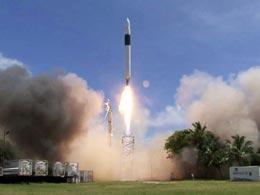SpaceX could pioneer a cheaper future for space flight.
 Blast off! Falcon 1 launches into space.SpaceX
Blast off! Falcon 1 launches into space.SpaceXThe fourth time was the charm for SpaceX and its Falcon 1 rocket, which soared into low Earth orbit after a successful launch yesterday.
After a trio of failed flights since March 2006, Space Exploration Technologies (SpaceX), based in Hawthorne, California, hopes that this marks the dawn of a new, substantially cheaper, era of space flight.
The rocket launched on Sunday 28 September at 23:15 GMT from the US Army Kwajalein Atoll on Omelek Island in the Pacific Ocean. "This is a great day for SpaceX and the culmination of an enormous amount of work by a great team," said Elon Musk, CEO and CTO of SpaceX, in a press statement. The company estimates that each launch will cost less than $10 million; existing systems can cost up to four times as much.
Falcon 1 is significant because it was developed from scratch by a private company, says Jonathan McDowell at the Harvard-Smithsonian Center for Astrophysics, in Cambridge, Massachusetts. The launch shows that the commercial sector can develop cheaper and, perhaps, better rockets that might one day rival those created by government agencies, adds Wolfgang Demisch, an aerospace consultant based in New York who has served on the US National Science Foundation's Next Generation Launch Technology panel. It's a "transformative step in space exploration," he says.
Right now, however, Falcon 1 can only carry up to one tonne of mass. To compete with existing launch systems, the Falcons must be able to carry more than ten times as much. For example, a space shuttle can carry a payload of about 25 tonnes into low Earth orbit, while the Apollo 11 mission to put man on the Moon carried an eye-watering 47 tonne combined payload.
But SpaceX is ambitious, and the launch bodes well for the company's development of larger heavy-lift rockets. Dubbed Falcon 9 and Falcon 9 Heavy, these rockets could potentially carry much bigger payloads further from Earth. Falcon 9 is designed to take around 12.5 tonnes into low Earth orbit and more than 4 tonnes into a highly elliptical geostationary transfer orbit — a key staging point for a geostationary satellite and for any astronauts or cargo heading to the Moon or Mars.
It could also act as an additional supply vehicle for the International Space Station once NASA winds down its space shuttle program in 2010. Falcon 9's estimated cost of around $37 million is less than a third of competing launchers.
McDowell says, however, that although Falcon 1's launch certainly "keeps SpaceX in the game" the company is "not out of the woods yet" because its commercial future really depends on their heavy-lift vehicles.
Just two days before its smaller sibling's jaunt into space, the company successfully test-fired all nine of the Falcon 9's engines simultaneously; its first launch is slated for next year.





No comments:
Post a Comment